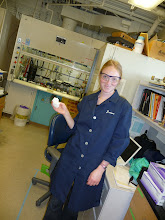Ever wonder why cyanide is so toxic? It looks pretty similar to a lot of other small anions... it has similar properties to a lot of other small anions... but it's also much more toxic than a lot of them. So what's so special about it?
All living, breathing humans (and other living, breathing prokaryotes) have an electron transport system/chain (ETS/C) in the mitochondiral membrane within their (our) cells. The main roll of this electron transport system is to--as the name implies--shuttle electrons around and in the process, make ATP. In other words, the electron transport system harnesses energy for the cells in our bodies. Without it, we can't really survive. It is part of the Kreb's cycle, which is a series of biochemical processes that break down food and convert it to energy.
The last step carried out by the ETS involves the transfer of hydrogen from an enzyme called cytochrome oxidase to oxygen, thereby producing water. Cyanide interacts with cytochrome oxidase in such a way to prevent it from functioning normally in this last step of the ETS. As a result, aerobic metabolism slows way down but glycolysis, which produces pyruvate, continues chugging away. So pyruvate builds up in the cells and gets converted to lactic acid, thereby lowering the delicately balanced pH of the cell. Simultaneously, ATP production grinds to a halt. Without energy, our bodies stop working, i.e., we die.




